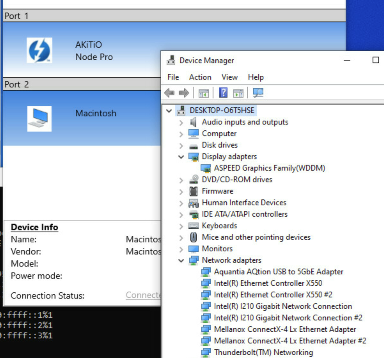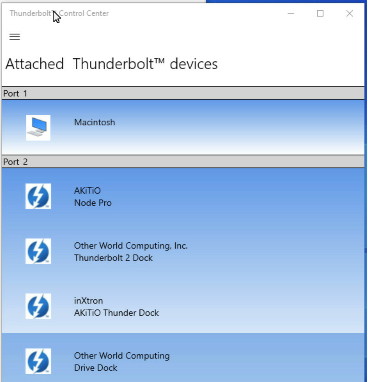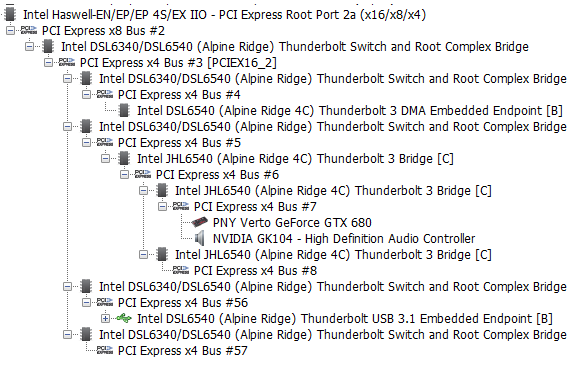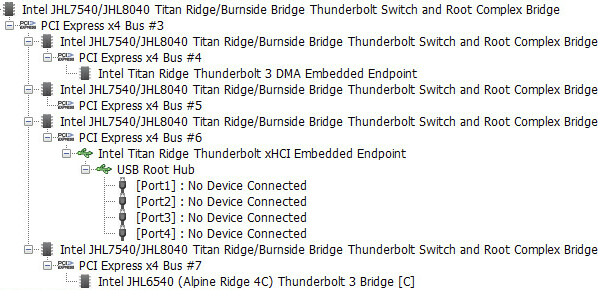Hold the phone… if there’s no tomfoolery, then what fun is there?
Ok, here we go… plugging in the Promise RAID array…
Hold the phone… if there’s no tomfoolery, then what fun is there?
Ok, here we go… plugging in the Promise RAID array…
sigh
I feel like I’m back in my ASUS days… what’s interesting is there is no sign of the Promise RAID driver in the Device Manager. It should be present once installed and the TB3 device is detected. The Windows Store TB app sees the device and it’s approved, but apparently not fully…
SOLUTION!
Thanks to @wendell - 10 more points gryffindor.
To get the Titan Ridge card working successfully with the Promise Pegasus32 R8 array over TB3, we kept getting a PCI to PCI bridge error.
I had isolated the error as the IPMI VGA driver - the VGA port on the board. I had disabled it in the BIOS but that proved ineffective. @wendell said to try the jumper on the board - BMC_VGA. Set the jumper to disable.
Still no spicey meatballs… tried a number of other things… and then @wendell says “You’ve been hard booting the IPMI, right?” Um… “No?” Doh. So a shut-down followed by 30+ seconds of no power to the IPMI so it could also reset.
Reboot and ta-da, TB3 RAID array!
Ended up with the Titan Ridge in PCI lane 1 - I could try moving it back to lane 2 at some point - not sure if moving the lane is part of the solution? We think it’s jumping the BMC_VGA to disable did the ultimate trick.
Thunberbolt BIOS settings - used the screenshots of @wendell above. Ended up bifurcating lane 1 to 4x4x4x4 - again, not sure if that’s critical.
When I reboot the system I do have to drop into the Device Manager to do a hardware scan which detects the TB3 device and mounts it - more work to do there.
I think that does it? Hopefully this will help others as this MOBO starts to get out there. Snip of my Device Manager - note the ASpeed VGA display adapter is not present - that proved to be key.
you can powershell the device refresh and make a desktop shortcut. I think if you set it back to no security it works. The dch driver is supposed to refresh the bus when it starts. Maybe its not starting automatically.
I just tweaked the BIOS to Native + RTD3 Cold and BINGO… more points gryffindor… auto-mounts now on reboot.
Yeah see I knew I just got ahead of myself because you had a more baseline issue
BIOS F4 took away the RTD3 Cold and RTD3 Hot Native options! sigh
Odd that they would remove functionality?
Does this mean that the onboard IPMI VGA graphics is incompatible with Thunderbolt use? Does disabling the BMC_VGA interfere with any other IPMI functionality, or just the ability to use the system without an added GPU for video out?
Interesting question - I am not sure. @wendell may have tried the onboard VGA on his system and can provide feedback. I don’t use the on-board VGA so used the jumper to disable it as it was the only way to avoid the device conflict with the TB3 AIC.
Oh boy. I have seen several post about the board with bad customer experiences. I also need Thunderbolt 3 on Threadripper with IPMI and at least three GPUs. It’s like a thriller. Nick from Gear Seekers says that the board is stable but I’m really suspicious.
I’m so close to buying the board but every week or so I do a Google Search and find new posts with issues.
My return window for my Threadripper PRO 3955WX processor is closing soon, as it is already sitting on the shelves for 2-3 weeks. Should I order or should I bailout? This is a huge money investment for me.
Absolutely 100% order my friend. The posts you are seeing are primarily due to peoples’ inexperience with server level boards. I couldn’t be happier with this MOBO - it’s truly awesome. Of course it has some wrinkles, but what board doesn’t?
When / if you get it, ping us back here and we’ll help you get it setup and you’ll be in bliss. I would strongly encourage you to stick with F3 firmware for now - F4 breaks a few things TB3.
Progressed with my build. I had no trouble using the on-board VGA and the GC-Titan Ridge 2.0 card. I also had no trouble with the VGA (enabled) and an installed AMD Radeon 5700XT GPU. I also had no trouble using the Thunderbolt while the BIOS was set to either UEFI without Secure Boot and UEFI with Secure Boot. (If VGA enabled or non-Secure Boot were giving @wendell trouble in the video, maybe it was some to other hardware conflict.)
Or, perhaps I should say, I had no trouble:

iperf3 -c 192.168.250.11 -P 1 -i 1 -f m -t 4 Connecting to host 192.168.250.11, port 5201 [ 5] local 192.168.250.10 port 64390 connected to 192.168.250.11 port 5201 [ ID] Interval Transfer Bitrate [ 5] 0.00-1.00 sec 582 MBytes 4883 Mbits/sec [ 5] 1.00-2.00 sec 584 MBytes 4900 Mbits/sec [ 5] 2.00-3.00 sec 586 MBytes 4912 Mbits/sec [ 5] 3.00-4.00 sec 583 MBytes 4894 Mbits/sec - - - - - - - - - - - - - - - - - - - - - - - - - [ ID] Interval Transfer Bitrate [ 5] 0.00-4.00 sec 2.28 GBytes 4897 Mbits/sec sender [ 5] 0.00-4.00 sec 2.28 GBytes 4897 Mbits/sec receiver iperf Done.
However, I am having some trouble with some older Thunderbolt gear – an Akitio Node Pro, and some old OWC Thunderbolt 2 gear behind an Apple Thunderbolt 3 to Thunderbolt 2 Adapter – not working as expected. Basically, these devices will connect and show up, and allow me to approve them, but their component hardware doesn’t show up.

I can test the same old Thunderbolt gear on my Macbook Pro Thunderbolt 3 and an Intel NUC6i7KYK Thunderbolt 3, and an Asus ThunderboltEX 3 on an old X299 motherboard and they all work fine.
The only other oddity I’m having on the WRX80-SU8 Thunderbolt is I seem to be able to connect USB devices (e.g. fingerprint reader, Yubikey, etc.) directly to the Thunderbolt ports on the GC-Alpine Ridge and they work fine, but USB drives (thumb drives, NVME in a USB 3.1 enclosure, etc.) do not work.
I played with the different BIOS setting and didn’t hit on any lucky combination that made things work, or work better. Also tried both BIOS versions F3 and F4.
I’m wondering if it’s just an older Thunderbolt incompatibility with the GC-Alpine Ridge since the WRX80-SU8-IPMI/GC-Alpine Ridge Thunderbolt seems to work fine with the Thunderbolt networking between it and the Macbook Pro. I hope I’m just missing a setting, however, as a large motivating factor for the Threadripper Pro-Thunderbolt purchase was hoped backward compatibility with with my past eGPU solution (Node Pro) as well as my older TB2 gear with Firewire support. I guess I can move on to newer gear, but this wouldn’t be the first time that Thunderbolt “incompatibilities” screwed me over.
I also had no trouble using the Thunderbolt while the BIOS was set to either UEFI without Secure Boot and UEFI with Secure Boot.
Which BIOS are you running? F4 or F3? I would enable secure boot for starters. While in Device Manager, click “Scan for hareware changes,” and see if that picks up the TB devices.
May be they are being seeing by the TB interface but Device Manager hasn’t recognized them - that’ll happen. Try the above and report back.
Which BIOS are you running? F4 or F3? I would enable secure boot for starters. While in Device Manager, click “Scan for hareware changes,” and see if that picks up the TB devices.
I switched to Secure Boot after initially just testing non-Secure Boot. I did most of the testing in BIOS F3 – and tried the different Legacy/Native/Native + RTD3Hot/Native + RTD3Hot combinations with no difference, before moving to F4 (where the RTD3 options go away).
In Device Manager, I did see a PCI-to-PCI device with an exclamation point in device manager when I had the Akitio Node Pro connected, and there seemed to be related errors in Event Log:
Device PCI\VEN_8086&DEV_15D3&SUBSYS_030C1CF0&REV_02\6&17dd5715&0&0020001C was configured.
Driver Name: pci.inf
Class Guid: {4d36e97d-e325-11ce-bfc1-08002be10318}
Driver Date: 06/21/2006
Driver Version: 10.0.19041.1151
Driver Provider: Microsoft
Driver Section: PCI_BRIDGE
Driver Rank: 0xFF2006
Matching Device Id: PCI\CC_0604
Outranked Drivers:
Device Updated: false
Parent Device: PCI\VEN_8086&DEV_15EA&SUBSYS_A2071458&REV_06\5&d375130&0&20001CDevice PCI\VEN_8086&DEV_15D3&SUBSYS_030C1CF0&REV_02\6&17dd5715&0&0020001C had a problem starting.
Driver Name: pci.inf
Class Guid: {4d36e97d-e325-11ce-bfc1-08002be10318}
Service: pci
Lower Filters:
Upper Filters:
Problem: 0x1F
Problem Status: 0xC0000010
However, updating the driver, disable/reenable device, unplug/replug device didn’t seem to resolve this problem on the WRX80-SU8-IPMI/GC-Titan Ridge Thunderbolt.
In contrast, on my old Intel NUC6i7KYK, this whole chain (Akitio Node Pro (as eGPU)-daisy chained Apple TB3-TB2 adapter, and a bunch of TB2 gear behind it), is all just plug and play. Here’s all the TB hardware in HWINFO64 on the NUC:
Here’s, the Node Pro on my Asus Sabertooth X99 with a ThunderboltEX 3 add-in-card:

Here’s the gear in my MacBookPro (with a SATA/SAS HBA in the Node Pro, rather than a Nvidia GTX 680):
But in the WRX80-SU8-IPMI/GC-Titan Ridge, it’s just crickets:

Any ideas for specific tests of any important steps of enumeration, recognition, compatibility, etc.?
I don’t have any newer Thunderbolt 3 gear, except workstations (which seem to work fine with Thunderbolt networking), and all of the peripherals I have are old and somewhat unusual (the Node Pro isn’t technically a certified eGPU, the TB2 is old and works through an adapter, etc.)
I have the PCIe power connected and power delivery/charging (through port one) works fine to my MacBook Pro. I connected the USB 2.0 header (although I didn’t test its use otherwise) – although I’m not sure what that connection does. And, I have the 5 pin TB motherboard header connected – and, as noted, I do see the hardware, and it works with Thunderbolt Networking.
Any ideas? Thanks!
I have lots of ideas of what to try, but at some point you have to ask yourself, “What’s an hour of my time worth and why am I still dragging along antique hardware?” Upgrade baby-cakes. You’ve been at this project for a few months now.
Do you think then it could be a reasonable hypothesis that the older Alpine Ridge peripherals I have could be incompatible with the newer Titan Ridge chipset (JHL7540/JHL8040) in the GC-Titan Ridge – while they work fine with the older Alpine Ridge Thunderbolt hosts I have (DSL6340/DSL3540 in Asus ThunderboltEX3 and JHL6540 in the NUC6i7KYK)? Has there been any other note elsewhere of this type of incompatibility? (Don’t most eGPUs still use Alpine Ridge chipsets, and a bunch use the same DSL6540 as my Akitio Node Pro – are there any components known to work/not work with GC-TITAN RIDGE?)
Or is it a red flag that my WRX80-SU8-IPMI/GC-TITIAN RIDGE Thunderbolt does NOT work with USB drives (but does with other USB devices). Does that perhaps suggest there is some setting off or hardware malfunction happening?
Heh, by the way, I only got my memory last Monday, spent some evenings over the week fitting the case, and bringing up the CPU/memory, and now this past weekend testing a battery of gear with the Thunderbolt. I do want to know if I have any hardware that needs RMA, and who knows, if its just a compatibility problem, maybe I need to go down to the GC-ALPINE RIDGE instead (I’m not going to miss DP 1.4 or power delivery anyway).
could be a reasonable hypothesis that the older Alpine Ridge peripherals I have could be incompatible with the newer Titan Ridge chipset
You need to address that question to the Intel folks. However, given AMD’s track record with TB over the years, I think you’ll likely be told to take a hike. And they’ll likely also tell you to upgrade your kit! 
you’ll likely be told to take a hike
Thunderbolt™ 3 – The USB-C that does it all!
Anyway, I ordered the following new Thunderbolt 3 gear to test:
Sonnet Echo Express SE IIIe (3-Slot PCIe Card Expansion Chassis)
TEKQ Cube Thunderbolt 3 SSD Enclosure
I also put in a support ticket with Akitio ("Hi, remember these discontinued products you used to sell…?), and a pre-sales support question in with Sonnet about any potential problems with AMD implementations of Thunderbolt with their product.
While I’m waiting for gear to arrive, and questions to be answered, I’ll probably test out that USB 2.0 motherboard port that the GC-TITIAN RIDGE plugs into, just to confirm it work.
Maybe I’ll try de-authorizing the non-working gear and try “No Security” mode, and maybe reauthorizing under “User Authentication” mode.
Any other extra BIOS tweaks anyone might suggest that sound relevant to this problem?
PBS | TR HR FPB Capability
PBS |Thunderbolt Security Level
PBS |Thunderbolt Force PWR
PBS |Thunderbolt Assign Resource
PBS |Thunderbolt MMIO Resource
PBS | Legacy/Native
PBS |Thunderbolt L1SS Support
PBS |Thunderbolt Wake Up Command
Sonnet Echo Express SE IIIe (3-Slot PCIe Card Expansion Chassis)
TEKQ Cube Thunderbolt 3 SSD Enclosure
I gotta ask why you are doing this? I’m not sure I understand how this is a benefit when you could just mount the SSDs to the MOBO?
Why am I buying an NVMe enclosure?
To have test device data supporting that my WRX80-SU8-IPMI/GC-TITAN-RIDGE is working.
To put to use some of the older PCIe 3.0 NVMe I have (I’ll mount PCIe 4.0 NVMe to the motherboard).
To have a high speed storage device that I can use for a system portable Windows To Go/Linux Desktop installation.
To have a high speed storage device that I can put some files on, and throw in my laptop bag to access with my MacBook Pro on the road?
Why am I buying a PCIe expansion chassis?
To have test device data supporting that my WRX80-SU8-IPMI/GC-TITAN-RIDGE is working.
To multiplex the Thunderbolt AIC slot with lower speed, infrequently used PCIe cards, like SATA/SAS HBA, Firewire cards, extra USB controllers. (So these things can take up only part of the x8 PCIe 4.0 slot on the motherboard, rather than additional x16 PCIe 4.0 slots.)
To add 25G Ethernet capability to my MacBook Pro laptop